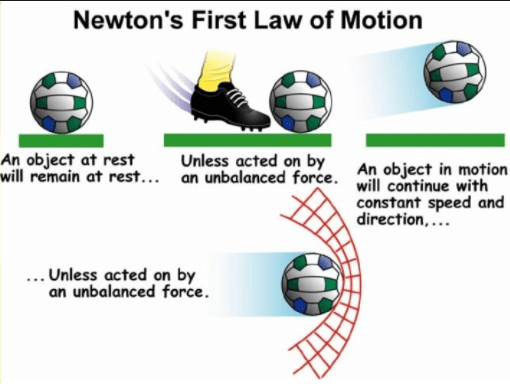
Project on Newton’s laws of Motion for Class 9th
Introduction
Background In the 17th century, Sir Isaac Newton, an English mathematician, physicist, and astronomer, left an indelible mark on the field of physics, revolutionizing our understanding of motion through his groundbreaking work. Newton’s Laws of Motion, a cornerstone of classical mechanics, stand as a testament to his profound contributions. Purpose of the Project This project embarks on a journey into Newton’s three laws of motion, unraveling their real-world applications and their relevance in our daily lives. By the project’s conclusion, you’ll possess a comprehensive understanding of the governing principles behind the motion of objects.
Newton’s First Law of Motion
Definition: Newton’s First Law of Motion declares that an object at rest remains at rest, and an object in motion persists with the same speed and direction unless acted upon by an unbalanced external force. This inherent resistance to changes in motion is known as inertia.
Examples: Imagine a book resting on a table—it stays still until an external force, like your hand, imparts motion. Similarly, a ball on a frictionless surface would roll endlessly unless influenced by external factors.
Practical Applications: In our daily lives, the design of seatbelts in cars prevents passengers from continuing in motion if the car abruptly stops. Understanding inertia is pivotal for implementing safety measures in vehicles.

Newton’s Second Law of Motion
Definition: Newton’s Second Law of Motion articulates that the force acting on an object equals the product of its mass and acceleration (F = ma). This law unravels how an object’s velocity changes under the influence of an external force.
Examples: Picture pushing both a car and a bicycle with the same force. The car, being more massive, experiences less acceleration than the lighter bicycle—a testament to the intricate relationship between force, mass, and acceleration.
Practical Applications: In fields like engineering, Newton’s second law guides the design of structures and vehicles, ensuring their ability to withstand external forces and providing insights into object motion under diverse conditions.

Newton’s Third Law of Motion
Definition: Newton’s Third Law of Motion asserts that for every action, there exists an equal and opposite reaction. When one object exerts force on another, the second object reciprocates with a force of equal magnitude but in the opposite direction.
Examples: Consider jumping off a diving board. Your downward push (action) is met with an upward force from the board (reaction), demonstrating equal and opposite forces.
Practical Applications: In rocket propulsion, Newton’s third law shines—expelling gases downward propels the rocket upward, overcoming Earth’s gravitational pull.
Experiments and Demonstrations
Simple Experiments : Engage in an inertia experiment by flicking a card with a coin—observe the coin’s resistance to motion due to inertia.
Interactive Demonstrations: Demonstrate Newton’s third law through a balloon rocket, showcasing the propulsion force as air rushes out, propelling the balloon in the opposite direction.
Importance of Newton’s Laws in Modern Science
Impact on: Physics Newton’s laws form the bedrock of classical mechanics, providing a framework for understanding and predicting object motion—an indispensable foundation in physics.
Connection to Other Scientific Principles: These laws seamlessly integrate with other scientific principles, such as conservation of energy and momentum, offering a holistic understanding of physical phenomena.
Conclusion
Summary: In summary, Newton’s Laws of Motion are foundational principles dictating the motion of objects. From inertia to the force-acceleration relationship, these laws have profound implications in both daily life and scientific exploration.
Closing Thoughts: This project aimed to unravel the mysteries behind Newton’s laws, offering insights into their applications and underscoring their significance in the world of physics. Remember, these laws aren’t mere equations; they are principles shaping our comprehension of the physical universe.
Certificate :
Certificate of Completion
[Student’s Name][Class/Grade Level]This is to certify that I, [Student’s Name], a [Class/Grade Level] student, have successfully completed the project on “Newton’s laws of Motion for Class 9th” The project explores the fundamental principles and key aspects of the chosen topic, providing a comprehensive understanding of its significance and implications.
In this project, I delved into in-depth research and analysis, investigating various facets and relevant theories related to the chosen topic. I demonstrated dedication, diligence, and a high level of sincerity throughout the project’s completion.
Key Achievements:
Thoroughly researched and analyzed Project on Newton’s laws of Motion for Class 9th.
Examined the historical background and evolution of the subject matter.
Explored the contributions of notable figures in the field.
Investigated the key theories and principles associated with the topic.
Discussed practical applications and real-world implications.
Considered critical viewpoints and alternative theories, fostering a well-rounded understanding.
This project has significantly enhanced my knowledge and critical thinking skills in the chosen field of study. It reflects my commitment to academic excellence and the pursuit of knowledge.
Date: [Date of Completion]Signature: [Your Signature] [School/Institution Name][Teacher’s/Examiner’s Name and Signature]
In order to download the PDF, You must follow on Youtube. Once done, Click on Submit
Follow On YoutubeSubscribed? Click on Confirm
Download Project on Newton’s laws of Motion for Class 9th PDF






